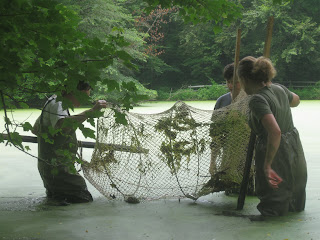The summer field experience had several goals:
- Introduce a group of community college students to methods of fieldwork;
- Have the students collect data on stream fish populations;
- Learn techniques of collecting and identifying organisms and gathering the data a biologist would require to assess a fish or turtle population;
- Become proficient in the use of a variety of measuring devices including dial calipers and weighing scales.
The students working on this project were a self-identified group chosen from members of my General Biology class. Students had to commit to working in the field one day per week, throughout the summer and adhere to this schedule despite the fact that no one was paid or given class credit for their efforts. It has always been my belief that students benefit greatly from academic activities that take them beyond the classroom. They experience real world applications of biology and put to practice what they learn in class.
Some of the behaviors and skills that students take away from this project include:
- A sense of responsibility by arriving at the project site in a consistent and timely manner;
- Cooperating with each other to collect and identify organisms and record data. No individual serves as a permanent “secretary” simply recording numbers and names. All students are actively engaged in all aspects of the project;
- The field site is a public area. Members of the public frequently come along and ask about our work. Students develop skills explaining, the research to the public;Handling an animal in a manner that minimizes stress to the animal and is safe for the students.
I would like to thank the staff of the Connecticut Audubon Society, particularly Dr. Twan Leenders, Conservation Biologist and Mr. Robert Martinez, President, for allowing us to use their facilities at the Roy and Margot Larsen Sanctuary. Dr. Leenders advice on trapping and marking turtles was invaluable to the project.
Dr. Tony Pappantoniou
Assistant Professor of Biology
Housatonic Community College
Bridgeport, Connecticut





No comments:
Post a Comment